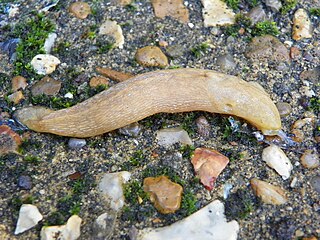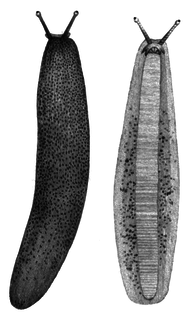
Limacus flavus, known commonly as the cellar slug, the yellow slug, or the tawny garden slug, is a medium to large species of air-breathing land slug, a terrestrial pulmonate gastropod mollusk in the family Limacidae.

Limax maximus, known by the common names great grey slug and leopard slug, is a species of slug in the family Limacidae, the keeled slugs. It is among the largest keeled slugs, Limax cinereoniger being the largest.

Bielzia coerulans, commonly known as the Carpathian blue slug or simply the blue slug, is a species of very large land slug, a terrestrial pulmonate gastropod in the family Limacidae, the keelback slugs.

Arion distinctus is a species of air-breathing land slug in the family Arionidae, sometimes known as the roundback slugs. It is a terrestrial pulmonate gastropod mollusc. Several vernacular names exist, but it is unclear if they are much in use: brown soil slug, common garden slug, darkface arion, Mabille's orange-soled slug, April slug.

Athoracophoridae, common name the leaf-veined slugs, are a family of air-breathing land slugs, terrestrial pulmonate gastropod mollusks in the infraorder Stylommatophora, the stalk-eyed snails and slugs. Many of the species have an attractive pattern on their dorsal surface which resembles the veins in a leaf, hence the common name.

Deroceras reticulatum, common names the "grey field slug" and "grey garden slug", is a species of small air-breathing land slug, a terrestrial pulmonate gastropod mollusk in the family Agriolimacidae. This species is an important agricultural pest.

Helicina is a genus of tropical and subtropical land snails with an operculum, terrestrial gastropod mollusks.

Radiodiscus is a genus of small air-breathing land snail, a terrestrial gastropod mollusk in the family Charopidae.

The Veronicellidae, also known by their common name the leatherleaf slugs, are a family of pulmonate terrestrial slugs.

Slug, or land slug, is a common name for any apparently shell-less terrestrial gastropod mollusc. The word slug is also often used as part of the common name of any gastropod mollusc that has no shell, a very reduced shell, or only a small internal shell, particularly sea slugs and semislugs.

Diplosolenodes occidentalis is a species of air-breathing land slug, a terrestrial pulmonate gastropod mollusk in the family Veronicellidae, the leatherleaf slugs.

Veronicella sloanii, commonly called the pancake slug, is a species of air-breathing land slug, a terrestrial, pulmonate gastropod mollusk in the family Veronicellidae, the leatherleaf slugs.
Angiostoma is a genus of parasitic nematodes in the family Angiostomatidae.

Sarasinula plebeia, commonly called the bean slug or the Caribbean leatherleaf slug, is a species of air-breathing land slug, a terrestrial pulmonate gastropod mollusk in the family Veronicellidae, the leatherleaf slugs.
Veronicella tenax, common Cuban name is the steak slug, is a species of air-breathing land slug, a terrestrial pulmonate gastropod mollusk in the family Veronicellidae, the leatherleaf slugs.

Phasmarhabditis hermaphrodita is a facultative parasitic nematode that can kill slugs and snails. It belongs to the family Rhabditidae, the same family as Caenorhabditis elegans. The Genus of Phasmarhabditis (Greek: Phasma = (φάσμα ; rhabditis = is made up of 10 species including P. hermaphrodita, P. neopapillosa, P. californica, P. papillosa, P. apuliae, P. bohemica, P. bonaquaense, P. huizhouensis, P. nidrosiensis, P. valida and P. tawfiki.

Solaropsis, also known by the common name sundial snails or sun snails, is a genus of air-breathing land snails, terrestrial pulmonate gastropod mollusks in the family Pleurodontidae.

Deroceras invadens is a species of air-breathing land slug, a terrestrial pulmonate gastropod mollusc in the family Agriolimacidae. Until 2011, this widely distributed species was known as Deroceras panormitanum, and earlier as Deroceras caruanae or Agriolimax caruanae, but Reise et al. (2011) showed that these names refer to a distinct species of similar external appearance known at that time only from Sicily and Malta. Consequently, although the more widespread species was already well known, it then had to be redescribed under the new name of D. invadens. Genetic evidence has indicated that D. invadens is native in southern Italy, including parts of Sicily, and possibly parts of central Italy. Elsewhere it has been introduced, predominantly within the last 100 years, but its spread has been constrained by cold winter temperatures.

Odontostomidae is a taxonomic family of medium-sized to large, air-breathing, tropical and sub-tropical land snails, terrestrial pulmonate gastropod molluscs in the superfamily Orthalicoidea.
















